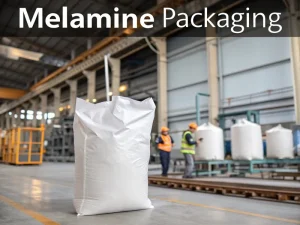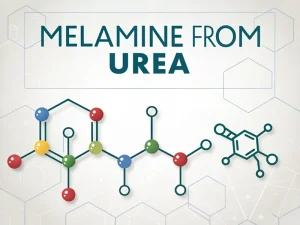
Melamine Packaging
Tech Blog Melamine packaging For manufacturers, inaccurate packaging not only fails to meet national standards but also increases labor costs and the risk of product

Melamine powder and melamine formaldehyde resin are closely related but serve distinct roles in industrial and consumer products. Understanding their differences is critical for us. This article compares melamine powder vs melamine formaldehyde resin chemical properties, production processes, applications.
Melamine chemical formula: C3H6N6
Melamine powder composition: A nitrogen-rich organic compound with a triazine ring structure.
Synthesis: Produced through urea decomposition at high temperatures (300-350°C) and high pressures.
Composition: Thermosetting polymer formed by the reaction of melamine and formaldehyde (molar ratio 1:2.5-3.0).
Synthesis: The amino group of melamine reacts with the carbonyl group of formaldehyde, initially forming hydroxymethyl (-CH2OH). Then, further reactions lead to the formation of a three-dimensional crosslinked network structure. The degree of crosslinking can be controlled by adjusting reaction conditions, such as the molar ratio of melamine to formaldehyde, reaction temperature, and the presence of catalysts.
Melamine Powder | Melamine Formaldehyde Resin | |
Appearance | White, odorless crystalline powder | Liquid or solid, usually in the form of particles after solidification |
Density | ~1.57 g/cm³ | 1.45–1.55 g/cm³ (cured) |
Thermal Stability | Decomposes at 345–347°C | Stable up to 160°C (long-term use) |
Solubility | Insoluble in cold water, in hot water is slightly higher. It is insoluble in most organic solvents. | Insoluble once cured |
Flame Retardancy | Moderate (releases nitrogen gas) | High (UL 94 V-0 rating) |
This reaction requires specific catalysts and strictly controlled reaction conditions to ensure high yield and high-quality production of melamine powder.
The production of melamine formaldehyde resin begins with mixing melamine powder and formaldehyde solution in a reactor. The reaction is carried out under controlled temperature and pH conditions. Catalysts such as sodium hydroxide or ammonia are usually added to promote the reaction.
The reaction is divided into two main stages: the formation of hydroxymethyl melamine intermediate, followed by a crosslinking reaction to form resin. After the reaction is complete, the resin can be further processed into various forms, such as moulding compounds or coatings.
Resin production: The main raw materials for MF resin and urea melamine formaldehyde (UMF) resin.
Flame retardant: Due to its high nitrogen content, melamine powder can be used as a flame retardant additive for plastics, textiles, and other materials. When added to these materials, they decompose at high temperatures, releasing nitrogen-containing gases that can dilute combustible gases and suppress the spread of fires.
Adhesive: used in the manufacturing of plywood and particleboard.
Speciality chemicals: intermediates of melamine cyanurate (MCA) and other derivatives.
Tableware: Melamine formaldehyde resin is widely used to produce tableware such as plates, bowls, and cups.
Laminated board: Decorative laminated board used for producing furniture, countertops, and wall panels.
Coatings: Heat-resistant coatings for automotive and aerospace components.
Electrical insulation: Melamine formaldehyde resin is used to produce electrical components such as switches, sockets, and circuit boards due to its excellent electrical insulation performance and thermal stability.
Although melamine powder and melamine formaldehyde resin are related, they have different characteristics in terms of chemical composition, physical and chemical properties, manufacturing processes, applications, and safety considerations. Melamine powder is the basic component of melamine formaldehyde resin, and both have their unique roles in various industries. Understanding these differences is crucial for industries that rely on these materials to ensure product quality, safety, and performance.

Tech Blog Melamine packaging For manufacturers, inaccurate packaging not only fails to meet national standards but also increases labor costs and the risk of product

Tech Blog How to Detect Melamine in Textiles? Melamine powder, a nitrogen-containing heterocyclic compound, is widely used in flame-retardant textiles and plastic products due to

Tech Blog melamine from urea Melamine is well-known for its wide range of applications, but its raw material for production is surprisingly urea. For manufacturers,

JINGJIANG MELAMINE POWDER
© JINJIANG MELAMINE